Petworth Hedge Cutting Contractors (GU28): If you've got hedges in your garden in Petworth you should always keep them trimmed and maintained. If you have the time and the right tools to do it, it is quite possible for you to cut your own hedges and keep them looking tidy and neat. However, most people in Petworth just don't have enough time to spare for this sort of routine maintenance or are not capable of, or fit enough to do such tasks. It is at times like this when it might be necessary to speak to the professionals.
It’s crucial to choose a hedge cutting specialist in Petworth with knowledge and experience in the field. Growing a healthy and attractive hedge can take a lot of money, so don't let untimely trimming or overzealous pruning ruin it. To ensure the best timing and techniques for trimming your cherished hedge, seek the guidance of a skilled hedge cutting specialist. Considering aspects such as size, type and growth rate, they will assess your hedge's unique requirements to ensure it thrives and maintains its beauty. Entrusting your hedge to a competent specialist protects your investment and ensures it flourishes as a stunning natural boundary.
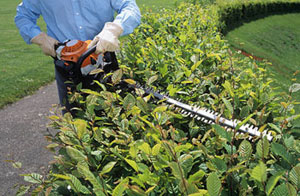
If the cutting of your hedges in Petworth entails fancy patterns like spirals, cones, arches, pyramids, lollipops and curves, calling on an experienced contractor is going to be even more essential. Along with pulling up weeds and mowing the lawn, most regular gardeners are going to be more than happy to also cut your hedges, although tall hedges might need to be looked after by a tree surgeon with the right safety equipment.
When done correctly, trimming a hedge helps to keep it strong and healthy, it both promotes new growth and strengthens the root system making the hedge denser and in a better position to combat diseases and attacks by pests. And along with accomplishing the aim it was established for - form an effective dividing line between yours and your neighbours garden, provide much needed shelter from windy weather and give you more privacy, a vibrant and strong hedge looks more appealing.
A hedge can quickly become patchy and top heavy when it's not correctly cared for, with unsightly holes and a lack of foliage and growth, particularly on the bottom half. Those gaping holes will soon be filled with new shoots if it's clipped continually, and should adopt a much tidier and more compact appearance as time goes by.
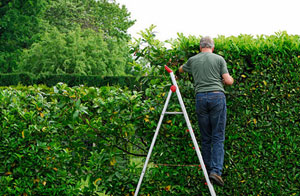
A hedge that's permitted to grow without attention will also spread outwards, taking up more of your garden space and generating a significant patch of leafless twigs internally which are going to look awful when you do ultimately cut it back. And if you suppose that your tatty hedge will recover quickly, you'll want to think again, since it is probably going to take several years before its looks reasonable once more.
You could be thinking about the cost of hedge trimming in Petworth, and the reality is that hedge cutting prices in Petworth depend on a few things including the size of the garden, the condition of the hedges, the height of the hedges, how many hedges need cutting and whether you need the hedge waste to be disposed of.
A cost-effective solution in the long term can actually be hiring a professional hedge trimming company in Petworth. Saving you money on costly replacements or treatments, a correctly maintained hedge is less likely to suffer from disease or pests.
Furthermore, if you plan to sell your property in the future, a well-trimmed hedge can enhance its overall look and potentially increase its value. Well-maintained landscaping, including healthy hedges, can be a key selling point for properties that appeal to potential buyers.
In terms of supporting biodiversity, hedges play an indispensable role. As important habitats and wildlife passages, they offer sanctuary, food, and safe traversal across various terrains. Birds nest in the dense foliage, while insects and small mammals find homes at their base. A range of species consume the hedge's flowers and fruits, as well as the multitude of insects it harbours. Hedges contribute to creating an array of microclimates by interrupting the landscape, thereby providing more niches for different wildlife. In addition, they serve as a sanctuary against predators and adverse weather. Hence, the upkeep and suitable management of our hedges is not just beneficial but paramount in the preservation of local fauna.
In short, if you have hedges on your property in Petworth, it's vital to properly maintain them to ensure their aesthetics and health. By hiring a professional hedge cutting service, you can benefit from time and effort savings, proper trimming techniques, improved safety, long-term cost savings and increased property value.
Hedge trimming can be provided in in Petworth and also in nearby places like: Barlavington, Selham, Graffham, East Lavington, Lodsworth, Coultershaw, Lower Fittleworth, South Ambersham, Fittleworth, Egdean, Gunter's Bridge, Tillington, Fox Hill, Rotherbridge, Byworth, and in these postcodes GU28 0DH, GU28 8BR, GU28 0BX, GU28 0AY, GU28 0FH, GU28 0BG, GU28 0AD, GU28 0EX, GU28 9JF, and GU28 9BF. Locally based Petworth hedge specialists will most likely have the postcode GU28 and the telephone code 01798. Checking this should guarantee that you are accessing locally based providers of hedge cutting. Petworth homeowners can benefit from these and various other similar services. Click the "Quote" banner to get quotations for hedge trimming.
Types of Hedge Petworth
Hedges can be formed from a whole host of diverse shrub and tree types and in some instances hedges are comprised of multiple species in which case they are known as mixed or natural hedges. The list of varieties grows significantly if you were to include hedgerows in the equation. Hedges can be evergreen, coniferous or deciduous and each of these groups has a number of varieties which are regularly used in hedges. Generally speaking hornbeam, leylandii, yew, privet, western red cedar, box, cherry laurel and beech are the most common species used for hedges in gardens. In hedgerows you can also add field maple, hawthorn, dog rose, oak, rowan, crab apple, hazel and many more. (Tags: Hedge Species Petworth, Hedge Varieties Petworth, Hedge Types Petworth, Hedge Selection Petworth, Hedging Plants Petworth)
Instant Hedging
The process of creating an instant visual barrier through the use of pre-grown plants is known as instant hedging. Commercial and residential properties can achieve security, privacy, and visual appeal effectively and efficiently by using this hedging. Instant hedging plants are grown in containers, meaning they are ready for installation as soon as they arrive in your garden. When compared to traditional hedging methods, they provide several advantages, including reduced installation time, immediate results, and lower maintenance.
Instant hedging is eco-friendly due to its ability to promote the growth of native plant species that provide habitats for birds and insects. Property owners in Petworth who desire an attractive and practical hedging solution can invest in carefully selected plants that possess adaptability, durability, and low maintenance needs. Additionally, instant hedging plants can also help reduce noise pollution, improve air quality, and offer shade and shelter to outdoor spaces. With the option of various sizes, species and colours, instant hedging plants provide householders with the ability to select the ideal combination to meet their unique requirements. Householders can have an attractive boundary established within hours rather than years by selecting instant hedging, allowing them to enjoy the benefits of mature plants without waiting. To conclude, with instant hedging, property owners can achieve an attractive and well-defined boundary in both residential and commercial properties in a practical and eco-friendly way. It offers immediate results, reduced installation time, and less maintenance, supporting the growth of indigenous plant species that provide habitats for birds, insects and small mammals and contributing to a healthier and greener environment.
Pruning Shrubs
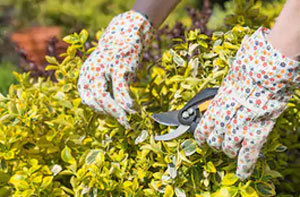
Regular pruning helps to keep your shrubs looking great, and above all, maintains their general health. Regrettably it is easy to damage shrubs and plants by pruning incorrectly, so it's always best to use an experienced gardener when it comes to pruning time in Petworth.
A decent gardening specialist in Petworth will be able to spot any damaged or dead sections of your shrubs and carefully prune them back to help rejuvenate them. If shrubs are positioned in a windy area they might grow too much to one side away from the prevailing wind, this will also be resolved to create a much more regular shape.
It is widely acknowledged in many bushes, trees and shrubs that fruit and berry production accelerates after pruning because it enables the plant to concentrate its resources on fruit bearing. (Tags: Shrub Pruning Petworth, Pruning Shrubs Petworth, Pruning Garden Shrubs Petworth).
Bird's Nests in Hedges
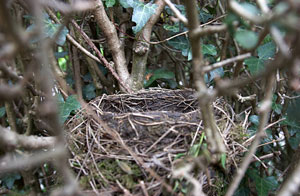
If you've not already thought of this, then you will need to consider the current law in relation to nesting birds before you go ahead and cut your hedges. Through the nesting bird breeding season, which is between March and August, the RSPB (Royal Society for the Protection of Birds) advises that the cutting back of hedges and trees should not be carried out. This is precisely the time that most people will be planning to trim their hedges. The Wildlife and Countryside Act (1981) actually states that it is a punishable offence "to intentionally take, damage or destroy the nest of any wild bird while it is in use or being built". Consequently it's advised that you check your hedges for bird's nests before you start clipping them back, so that our prized wildlife can be preserved. (Tags: Nesting Birds, Bird Nests in Hedges, Bird's Nests)
Do You Cut Top or Side of Hedge First?
One should start with the sides before moving onto the top when it comes to trimming a hedge.
- Sides: From the bottom up, proceed with your trimming to cultivate a slight slope, or "batter", on both sides of the hedge. Ensuring a broader base than the top allows for sunlight to reach the lower branches, hence maintaining a robust and lush hedge throughout.
- Top: The trimming of the top can follow after you've taken care of the sides. For tall hedges in particular, this tends to be the most formidable part of the process. Make the most of a reliable step ladder, and work to keep the cuts equal, thus resulting in a top that is level and flat.
If you find your hedge significantly overgrown, trimming over several seasons may be advisable, particularly when more than a third of the hedge's total volume needs to be removed. Using this strategy can avert the over-stressing of the plants in one go. Remember, it's crucial to clean up post-trimming to stop the spread of diseases and retain your garden's neatness.
Privet Hedges Petworth
All through Petworth, gardens often feature privet hedges, noted for their dense greenery and precise lines. Often undervalued, these unassuming shrubs offer a number of benefits, making them a popular choice for landscapers and homeowners alike. While they may appear simply decorative, privet hedges offer a surprising range of benefits:
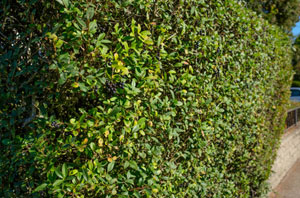
- Pollution Tolerance: Privet hedges show a surprising resilience to air pollution, which makes them ideally suited to urban settings.
- Informal or Formal Styles: Depending on the variety and pruning strategy, privet hedges can be cut into both formal, geometric shapes or a more relaxed, informal style.
- Low Maintenance: Privet hedges are well-known for being low-maintenance. They happily grow in most soil types and only need occasional pruning to stay looking their best.
- Privacy and Screening: The lush foliage of a well-trimmed privet hedge serves as a visual barrier, ensuring privacy from both passers-by and neighbours and can be employed to hide less appealing parts of your garden.
- Fast-Growing: If you're on the lookout for a rapid privacy solution, these hedges are a good choice. They have a fast rate of growth, enabling you to establish a substantial barrier in a relatively short time period.
- Habitat for Wildlife: While not known for attracting a wide variety of wildlife, privet hedges offer nesting areas for wild birds. They also provide a useful food source via their black berries - but be careful, these are slightly poisonous to humans.
- Noise Dampening: When located near to busy roads in Petworth, or areas that experience significant noise, gardens benefit from the compact foliage's role as a natural sound insulator.
- Cost-Effective Alternative: In comparison to alternative screening methods like fences, privet hedges present an economical choice. They necessitate fewer materials and less continuous upkeep, making them a budget-wise solution.
Planting and Caring for Your Privet Hedge
Establishing a privet hedge is surprisingly straightforward, requiring minimal fuss for both planting and aftercare:
- Pruning: Regular trims, in late spring or early summertime, are key to achieving and keeping your desired hedge size and shape.
- Choosing the Right Location: Drainage is key! Choose a sunny or partially shaded spot with well-draining soil for optimal plant growth.
- Spacing: For a thick, established hedge, consider the mature size of the plants when spacing them out. The usual recommendation is 16-24in (40-60cm) between individual shrubs.
- Watering: Don't skimp on watering during that first 12 months! Regular watering is vital for establishing the roots of your privet hedge. The good news is, once established, they're quite resilient to dry weather.
- Planting Time: Season matters when planting privet hedges! Choose spring or autumn to benefit from moist (but not saturated) soil conditions.
- Feeding: Encouraging healthy growth in your plants is achievable without fertiliser, but a balanced application in spring can certainly make a difference.
For Petworth gardens, the unassuming privet hedge presents numerous benefits, including screening, privacy and noise reduction, with hardly any maintenance needed.
Box Hedging Petworth
Box is a superb species to use for hedges, particularly for smaller boundaries, edging and borders. When trimmed on a regular basis, box will develop into a bushy and neat hedge that should grow to a height of 1m in a timescale of approximately ten years from 15-20cm plants. Suited to both smaller sized contemporary gardens and large formal gardens, box hedging plants (Buxus sempervirens) are readily available online or from garden centres. Box hedges can last for a long time, and you can find examples in historic gardens around Britain that date from the 17th century.
When planted in suitable soil and conditions, box plants, once established, will grow by around 6 inches a year, however this rate of growth could be substantially lower when grown in a shady area or in soil of a poor calibre. Nevertheless, there are relatively few settings that box hedge plants will not grow in, and they are able to tolerate alkaline or acid soils, and are happy in both sand or clay. The worst kind of environment for a box hedge is boggy or waterlogged ground, where it will find it hard to thrive.
If you haven't got the patience to wait years and years for a box hedge to grow, you can even buy "instant box hedging" from some UK suppliers. You can purchase this hedging as a row of plants grown in a trough, and pruned into the shape of a hedge as they mature, which can be placed end to end to form whichever length of hedge you need, or single plants about 25-30cm high, which are pre-clipped into a uniform shape, which when planted in a row form your "instant hedge". Giving an immediate impact, a lot of hard graft can be sidestepped by using this approach. Through the years as they continue to grow, you will obviously have to keep them neatly trimmed to maintain their form and shape.
Hedge Planting
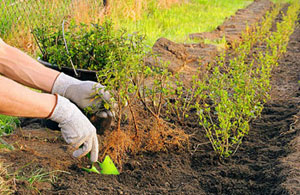
Whereas certain folks in Petworth are put off planting hedges because of the work load that is necessary to keep them cut back, it's obvious that hedges are far more appealing and long lived than regular wooden fencing for example. The alternate choice of putting up a brickwork boundary wall is an expensive enterprise, and while long lasting, could prove too costly for most average Petworth property owners. I do think we'd all accept that a hedge will establish a boundary which is both functional and attractive, and offers a much needed home for wildlife, in particular small mammals and nesting birds. The ideal time to plant a new hedgerow is Autumn, when the ground is generally easy to dig, not waterlogged, and is still relatively warm from the hot summertime days that went before.
Your local Petworth hedge planting specialist will happily tell you what you should plant and when to put it in, however as a rough guideline, Autumn is great for putting in hornbeam, box, privet and yew hedges. Naturally the variety you decide to grow will be dependent on the design of hedge you are shooting for and precisely what purpose it is going to perform. You might want screening hedging, low hedging, a natural hedgerow or instant hedging. Ask a hedge planting expert in Petworth to give you advice.
When Should You Clip Hedges in Petworth?
This may depend on the type and age of the hedge, and is a question asked by many property owners in Petworth. When it comes to brand new hedges, they should be cut during the winter time or in the spring until they're two or three years old. In order to maintain their shape and density, well established hedges ought to be cut back 2 or 3 times each year. The period May through to September is the best time to do normal maintenance hedge trimming. Different pruning procedures are needed for certain varieties of hedge, therefore before you do any major cutting back of your hedges check with a specialist or check on the RHS website for the right guidance.
Hedge Height Reduction Petworth
In Petworth gardens, hedges can serve multiple different purposes. Hedges are not only aesthetically pleasing, but they also provide habitats for wildlife, provide privacy and act as windbreaks. With time, hedges can grow very tall and lose their function and form if they are not maintained correctly, and this can happen in a way that is out of control. Hedge height reduction steps into focus here, providing a remedy for overgrown hedges whilst preserving their value in the garden.
The maintenance of hedges, especially those that are overgrown or extremely tall, includes reducing their height. This involves the selective reduction of the hedge's height, bringing it to a level that's both more visually appealing and manageable. The process is beneficial in not only improving the hedge's look but also in allowing more sunlight to nourish the lower parts, which results in more lush, and healthier growth. Meticulous techniques are required for extensive height reductions, and because it can greatly affect the shape and health of the hedge, qualified professionals should carry out this work.
Nevertheless, as crucial as hedge height reduction is, it's not a procedure without its risks. When mishandled, it can result in harm to the hedge, making it susceptible to disease or causing its death. For major adjustments in hedge height, it's crucial to rely on specialists. With their expertise, they know the optimal times to trim, the best methods to use, and how to undertake the task without overburdening the plant.
Hedge height reduction is not just about cutting down the top section of the hedge to achieve the required height. To master this art, one must have expertise, precision, and an awareness of the plant species involved. Different species of hedge vary in their resilience, growth pattern and rate. Ignoring these variables when reducing hedge height can damage its health and appearance.
To conclude, trimming hedges to reduce their height is a necessary part of garden maintenance, as it ensures their beauty and health. Whilst it may seem to be a straightforward process, the underlying nuances warrant a vigilant approach, preferably under the tutelage of a practiced professional. This guarantees that the hedge remains a treasured feature of the garden, thriving in all its glory. (32035 - Hedge Height Reduction Petworth)
More Petworth Tradespeople: You may also be searching for weeding services in Petworth, fencing contractors in Petworth, tree surgeons in Petworth, SKIP HIRE in Petworth, garden clearance in Petworth, landscape gardeners in Petworth, patio builders in Petworth, garden designers in Petworth, garden shed installation in Petworth, a builder in Petworth, carpenters in Petworth, driveway cleaning in Petworth, pond maintenance in Petworth, grass cutting in Petworth, soil drainage services in Petworth, decking fitters in Petworth, gardeners in Petworth, artificial grass installers in Petworth, block pavers in Petworth, a bricklayer in Petworth.
Hedge Cutting Tasks Petworth

Petworth hedge cutting contractors will likely help you with juniper hedge trimming, maze hedge clipping, garden hedge pruning, domestic hedge trimming in Petworth, tree cutting, lilac hedge clipping, yew hedge planting, hedge re-planting, hedge height lowering, roadside hedge trimming, hedge thinning & crown reduction, hedge shaping, hedge lowering, hedge transplanting & relocation, tree surgery, conifer hedge cutting, box hedge pruning, ficus hedge planting, hedge landscaping in Petworth, home hedge cutting in Petworth, hornbeam hedge cutting and pruning, tall hedge cutting in Petworth, hedge makeovers, hawthorn hedge cutting in Petworth, boundary hedge cutting in Petworth, domestic hedge cutting in Petworth, help with removing a hedge, hedge pest control, ivy removal, wood chipping and other hedge related tasks in Petworth.
These are just an example of the activities that are undertaken by people specialising in hedge trimming. Petworth companies will keep you informed about their full range of hedge cutting services.Hedge Cutting Near Petworth
Also find: Tillington hedge cutting, Coultershaw hedge cutting, Gunter's Bridge hedge cutting, Byworth hedge cutting, Rotherbridge hedge cutting, Fittleworth hedge cutting, Graffham hedge cutting, Selham hedge cutting, Barlavington hedge cutting, Lower Fittleworth hedge cutting, Fox Hill hedge cutting, East Lavington hedge cutting, Lodsworth hedge cutting, South Ambersham hedge cutting, Egdean hedge cutting and more. Dedicated hedge cutting specialists and experienced gardeners handle the essential task of hedge maintenance in all these places. Such professionals, often unnoticed, play a pivotal role in enhancing the visual appeal and ecological equilibrium of their communities, making them unsung heroes of local greenery. Hedge cutting specialists possess the know-how and expertise required to transform unruly hedges into visually pleasing, well-groomed boundaries. Local residents and business owners can hedge trimming quotes by clicking here.
Hedge Cutting Contractors Petworth - Hedge Removal Petworth - Hedge Maintenance Petworth - Hedge Cutting Petworth - Hedge Planting Petworth - Conifer Trimming Petworth - Hedge Clipping Petworth - Hedge Trimming Petworth - Hedge Cutting Near Me



